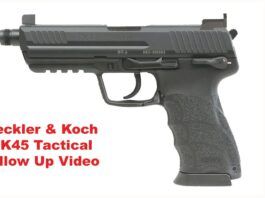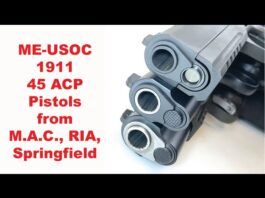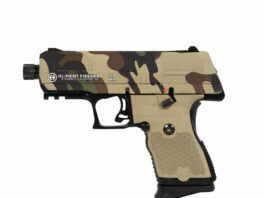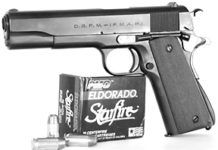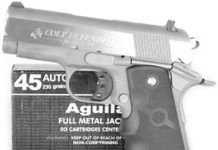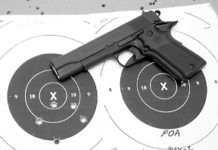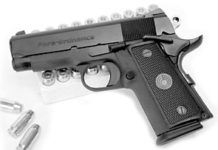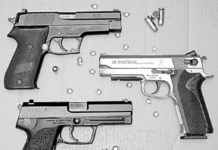Full-Size Fighting 1911s: Valtro Beats Wilsons CQB
One of our representatives recently spoke with a fellow who has, to put it gently, a vanilla outlook on the world. That fellow declared his chances of getting in a gunfight were around one in a million. He thought the chance was so remote that it would do him no good to either prepare himself with proper gunfighting training, nor to begin to understand what constitutes a suitable and properly set up fighting handgun.
Foreign Surplus .45s: Bargains, Or A Waste of Your Money?
In our search for the least expensive, but still functional, .45-caliber semi-automatics, it was inevitable we would finally bottom out with guns in the $200 to $350 price range. If you'll recollect, we tested two guns in that dollar span in the September 2001 issue, the Llama MAX-1, $298, and the Firestorm 45, $329, two of the lowest cost 1911s we could find. They were so badly flawed we said "Don't Buy" to both of them.
Lightweight Commander 1911s: Powerful .45 ACP Packages
We recently queried a number of custom gunsmiths to learn what they recommend as a reliable, easy to pack, powerful carry gun. A popular answer was an Officer's frame with a Commander length slide, a combination which marries a longer slide (to make the pistol more reliable) with a shorter grip frame (to make it easier to conceal). Perhaps it was this reasoning that prompted Springfield Armory to introduce its new Compact pistol, which for all intents and purposes has replaced the Champion Lightweight (a true Commander-sized pistol).
Sub-Compact .45 Semi-Autos: Colts Defender Gets The Nod
Colt's alloy Defender may be the best little 1911 yet, but Springfield's lightweight Ultra Compact is another value-laden contender. Taurus's PT145 packs the most rounds per dollar.
More .45 ACP Semi-Autos: Stay Away From Llama and Firestorm
Colt's Model XSE model is a second-step upgrade that does all you would ask of a defense gun. Basic models from Llama and Firestorm shot poorly or malfunctioned during testing.
Lightweight .45 ACP Officers Models: Potent Carry Pieces
Small semiautos that match the physical dimensions of two pistols we tested recently—the $1,695 Smith & Wesson 945 and Para-Ordnance's $740 P12-45—are usually referred to as compacts or sub-compact. But when pistols of this size class are miniaturized 1911s, the tag of "Officer's models" is hung on to them, even though they may not exactly fit the mold of the original Colt's Officer's model. In fact, the Smith & Wesson 945 stretches the designation even further by offering a variation on John Browning's action lock up. Still, the physical operation the 945 affords is decidedly 1911 in nature, since it shoots the .45 ACP and can be carried cocked and locked.
Manufacturers are taking a fresh look at the Officer's model for a number of reasons. For one, the 1911 pistol has legions of fans inside both competitive shooting and law-enforcement circles. Also, many military and ex-military personnel recognize the .45 ACP's superiority over the 9mm Parabellum, a cartridge choice often perceived as NATO's intrusion into American affairs. Once the United States government set a capacity limit for civilian handguns, the trend has been toward larger-caliber rounds, even when this means lower total capacity. Traditionally the Officer's model offered a six-round magazine, like the 945's. However, the Para Ordnance P12 integrates a double-stack or staggered-round magazine that in civilian trim will hold the full ten-round legal limit.
Full-Size Double Action .45 ACPs: We Like SIGs TDA P220 Best
The SIG P220 and Smith & Wesson's 4566TSW successfully bridge the gap between single- and double-action .45s. The polymer H&K USP45 offers cocked-&-locked operation.
USPSA Limited 10-Division Guns: We Test Four Practical Pistols
After testing .45 ACP and .40 S&W pistols from Para Ordnance, CZ-USA, and STI, we found that pistol companies are making great guns for this new classification.
Ruger P-90 Our Pick In An Affordable .45 ACP Double Action Pistol
Slowly but surely, the .45 ACP is regaining its preeminent position as a personal defense round. The fact that it always was the best got lost for a while when the Pentagon had to conform to NATO's use of the 9mm. Historically, anything adopted for the American soldier creates a lemming-like demand for the same in the civilian marketplace.
Forget that it was adopted primarily for political reasons. Forget that the 9mm never could compare with the .45 ACP as a stopper. A slew of DA/SA (double action/single action) 9mm platforms with high capacity magazines evolved and were gobbled up by an eager public. The magazines eventually begat gun laws limiting capacity, ergo the declining appeal of...
Astra A-100 Carry Comp: Worked Well, Average Accuracy
Most compensated .45 ACP pistol are designed for competitive shooting, so there arent very practical for defensive use. However, European American Armory offers a pistol that is suitable for this type of work. It is called the Astra A-100 Carry Comp.
This $534 model is a standard A-100 equipped with a single-port compensator that screws onto the guns 3 1/2-inch barrel. It features a double action...
H&K USP45 Compact Beat Glock, EAA Polymer .45 ACP Compacts
Whether you love them or hate them, you've got to admit that pistols with polymer frames are becoming very popular. There are a number of good reasons for this trend. A polymer frame is lighter and more corrosion-resistant than a steel frame. Furthermore, it doesn't conduct hot and cold as well as metal. Have you ever picked up a gun that has been exposed to extremely hot or cold weather for a couple of hours? Ouch!
A polymer frame on a compact pistol makes a lot of sense. Carrying a lighter handgun is certainly easier than dragging around a heavier one. During the heat of the summer, sweat won't cause the polymer parts of your carry gun to start rusting. Also, a polymer-framed pistol's i...
Springfield Trophy Match A Better Buy Than Kimber, Colt .45s
An out-of-the-box 1911 pistol that shoots 3-1/2- to 4-inch groups at 25 yards might be suitable for personal protection. However, such a pistol isn't even close to adequate for formal target shooting, such as a bullseye match. To be competitive, you need a pistol that is at least capable of 2-inch groups at 25 yards. A handgun that will produce 1-inch or smaller groups at that distance would be ideal.
Several custom pistolsmiths make very nice, extremely accurate target pistols, but these guns are priced in the $2,000 to $4,000 range. What do you do if your checkbook can't take that big of a hit? The answer is simple. Buy a factory-made match pistol that will only cost you an arm, instea...



























